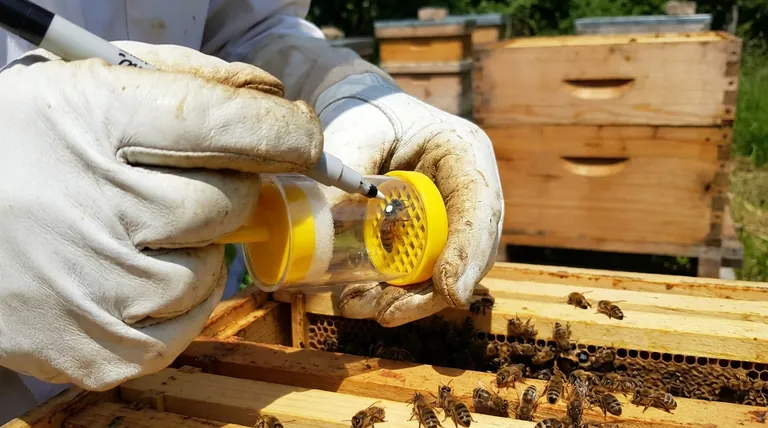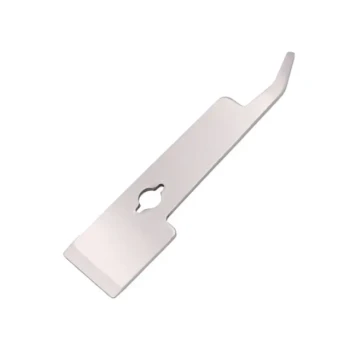The best time to mark a queen bee is after she is fully established in the hive. This means she has completed her mating flights, has been accepted by the colony, and has started laying eggs in a consistent pattern. Marking her at this stage minimizes the risk of rejection or harm during a critical period of her development.
The decision of when to mark a queen is not about a calendar date, but about a biological milestone. The goal is to act only when the queen is proven—mated, laying, and accepted—to ensure the procedure does not disrupt the delicate chemistry of the colony or endanger the queen herself.

Why Marking a Queen is a Critical Management Tool
Marking a queen isn't just for aesthetics; it's a fundamental practice for efficient and proactive hive management. It transforms a chaotic inspection into a targeted assessment.
Easily Identify Your Queen
A small, bright dot on the queen's thorax makes her instantly visible among thousands of worker bees. This saves you significant time and reduces the disruption caused by prolonged hive inspections.
Track Her Age and Performance
Beekeepers use an international color code to mark queens based on the year they were hatched. This system allows you to know her age at a glance, which is a key indicator of her egg-laying potential and the overall vigor of the colony.
Confirm Her Lineage
A marked queen confirms that the colony is headed by the queen you introduced. If you later find an unmarked queen, you know the hive has superseded her, and the new queen's genetics are unknown.
Monitor Colony Health
Younger queens lay more prolifically and produce more of the "queen substance" pheromone. This chemical signal is vital for colony cohesion, morale, and swarm prevention. Tracking the queen's age helps you anticipate and manage these colony-level behaviors.
Pinpointing the Ideal Moment for Marking
Timing is everything. Acting at the wrong moment can cause the colony to reject the queen or lead to her injury.
The Golden Rule: After Mating and Laying
The most critical prerequisite is that the queen has successfully mated and is now laying. A queen that is actively laying eggs has proven her viability and is fully integrated into her role, making her less likely to be viewed as an intruder after the brief marking process.
For Introduced Queens: Ensure Colony Acceptance
If you introduce a new, unmarked queen, do not mark her immediately. Give her at least a week to be released from her cage, accepted by the workers, and settle into a routine. Waiting ensures the stress of marking is not compounded by the stress of introduction.
Favorable Weather Conditions
Choose a calm, warm, and sunny day for your hive inspection. Good weather keeps the colony calm and allows you to work carefully and deliberately without being rushed by rain or cold, which reduces the risk of accidentally harming the queen.
Understanding the Common Pitfalls
Marking a queen is a simple procedure, but small mistakes can have significant consequences. Knowing the risks is the first step to avoiding them.
The Risk of Premature Marking
Never mark a virgin queen before her mating flights. The stress and foreign scent can interfere with her orientation flights or cause the hive to reject her upon her return.
The Danger of Incorrect Placement
The mark must be a single, small dot on the thorax—the hard plate between her wing joints. Getting paint on her wings, antennae, eyes, or joints can impede her movement, block her senses, and trigger rejection by the workers.
The Threat of Physical Harm
The queen is resilient but not indestructible. When using a marking tube or cage, be gentle. Use minimal pressure to hold her in place, as crushing her thorax or abdomen is a fatal mistake.
Overusing Your Smoker
Excessive smoke can cause chaos in the hive and will often make the queen run and hide, making her much more difficult to find. Use only small, necessary puffs of cool, white smoke to manage the colony during your search.
Making the Right Choice for Your Goal
Your approach to marking should align with your experience level and goals for the hive.
- If your primary focus is safety and simplicity: Request that your bee supplier mark the queen before shipping. This is the most common and risk-free option, especially for new beekeepers.
- If your primary focus is raising your own queens: Wait until your new queen has established a solid, visible laying pattern before you attempt to mark her yourself.
- If your primary focus is introducing a new, unmarked queen: Allow her to be fully accepted and begin laying for several days to a week before you go back into the hive to find and mark her.
Mastering this technique is a foundational step toward becoming a more confident and knowledgeable beekeeper.
Summary Table:
| Timing Milestone | Key Action | Rationale |
|---|---|---|
| After Mating & Laying | Mark the queen | She is proven, viable, and accepted by the colony. |
| For Introduced Queens | Wait 1+ week after release | Ensures colony acceptance before adding marking stress. |
| Favorable Weather | Choose a calm, warm, sunny day | Keeps the colony calm for a careful, deliberate procedure. |
Maximize your apiary's productivity and health with professional-grade supplies from HONESTBEE.
As a trusted wholesale supplier for commercial apiaries and beekeeping equipment distributors, we provide the durable tools and equipment you need for precise queen marking and effective hive management. Ensure every procedure is a success with reliable gear designed for professional beekeepers.
Contact HONESTBEE today to discuss your wholesale needs and discover how our supplies can support your operation's growth and efficiency.
Visual Guide

Related Products
- Queen Bee Marking Tube Cage Bottle Catcher Holder with Clear Plastic Plunger Marker
- Plastic Queen Bee Catcher Marker Tube Holder for Queen Marking Bottle
- Double Head Beekeeping Grafting Tools for Beekeepers
- HONESTBEE Professional Long Handled Hive Tool with Precision Cutting Blade
- Professional Dual-End Stainless Steel Hive Tool for Beekeeping
People Also Ask
- What are the benefits of marking a queen bee? Boost Efficiency & Hive Health
- What is the purpose of marking a Queen bee? Boost Hive Management with Instant Identification
- How does marking a Queen bee help in age tracking? Boost Hive Productivity with Clear Identification
- What tools and skills are needed to mark a queen bee? Master the Art of Safe & Effective Queen Marking
- What should you do immediately after marking a bee? Ensure a Clean, Durable Mark with This Key Step



















